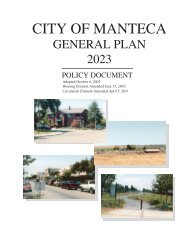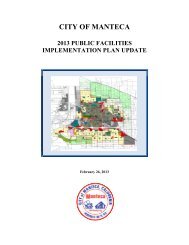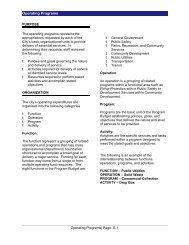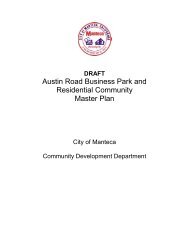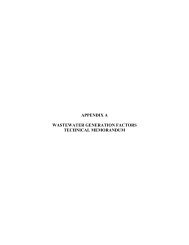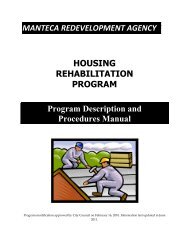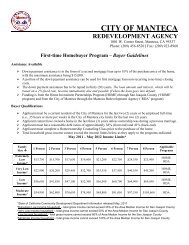R - City of Manteca
R - City of Manteca
R - City of Manteca
Create successful ePaper yourself
Turn your PDF publications into a flip-book with our unique Google optimized e-Paper software.
DRAFT (As <strong>of</strong> 2/1//2013)<br />
CHAPTER 1 OVERVIEW<br />
Of the many services provided by the <strong>City</strong> <strong>of</strong> <strong>Manteca</strong> (<strong>City</strong>), the <strong>City</strong> strives to provide<br />
adequate control <strong>of</strong> stormwater to protect residents and businesses from flooding while<br />
meeting all stormwater regulatory requirements. The <strong>City</strong> accomplishes this essential service by<br />
1) providing and maintaining a system <strong>of</strong> storm drains, detention basins and pumping facilities;<br />
2) by monitoring and controlling the operations <strong>of</strong> the storm drainage system, and 3) by<br />
enforcing storm drainage regulations established by the Environmental Protection Agency (EPA)<br />
and the State <strong>of</strong> California.<br />
A comprehensive Storm Drain Master Plan (SDMP) supports the essential service <strong>of</strong> storm<br />
drainage control, disposal and regulatory compliance by assessing the condition <strong>of</strong> existing<br />
drainage facilities and by identifying additional facilities needed to accommodate run<strong>of</strong>f from<br />
future development.<br />
The backbone <strong>of</strong> the SDMP is the <strong>City</strong>’s dynamic computer model <strong>of</strong> its storm drainage system.<br />
The model was formulated as an XP‐SWMM model, a model originally developed by the EPA,<br />
and the present version was advanced by a private sector firm, XP S<strong>of</strong>tware, Inc. A dynamic<br />
model allows analysis over time and provides the ability to maximize the efficiency <strong>of</strong> detention<br />
basin and pump operation along with ability to monitor and control downstream water levels<br />
to minimize flooding problems with a minimum <strong>of</strong> new capital improvements.<br />
SDMP Organization<br />
Chapter 2 – Policies presents a summary <strong>of</strong> policies for the existing and future storm<br />
drainage systems.<br />
Chapter 3 – Planning & Design Criteria presents criteria used to evaluate existing drainage<br />
facilities and to plan for future drainage facilities. This criterion is also intended to serve as<br />
a guide for the design <strong>of</strong> on‐site drainage systems.<br />
Chapter 4 – Existing Conditions evaluates the existing storm drainage system, identifies<br />
existing deficiencies and identifies needed drainage improvements.<br />
Chapter 5 – Buildout Conditions provides the analysis results from future growth modeling<br />
scenarios, and identifies the capital improvement projects necessary to accommodate new<br />
development in the <strong>City</strong>’s 2023 General Plan Boundary.<br />
Chapter 6 – Capital Improvement Program provides cost estimates for the various drainage<br />
capital improvements and prioritizes the improvements in terms <strong>of</strong> greatest need.<br />
4




